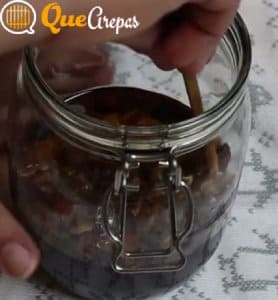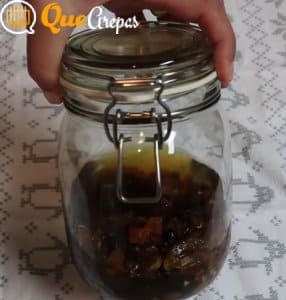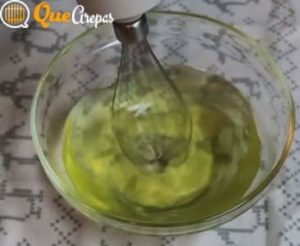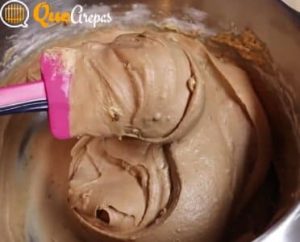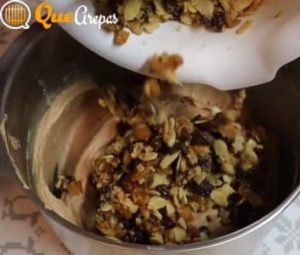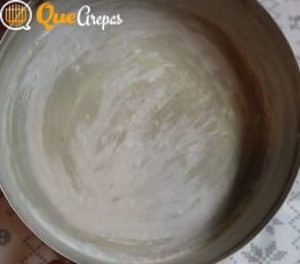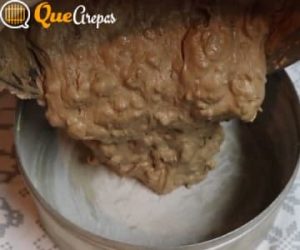Venezuelan Black Cake: A Delicious Feast of Flavors and Tradition
Get ready for a unique culinary journey as we explore the irresistible and enigmatic Venezuelan Black Cake. With its history rooted in centuries-old traditions and its exquisite blend of flavors, this delicacy captivates the senses and ignites the spark of nostalgia. Discover how each ingredient fuses into a masterpiece of flavor and culture.
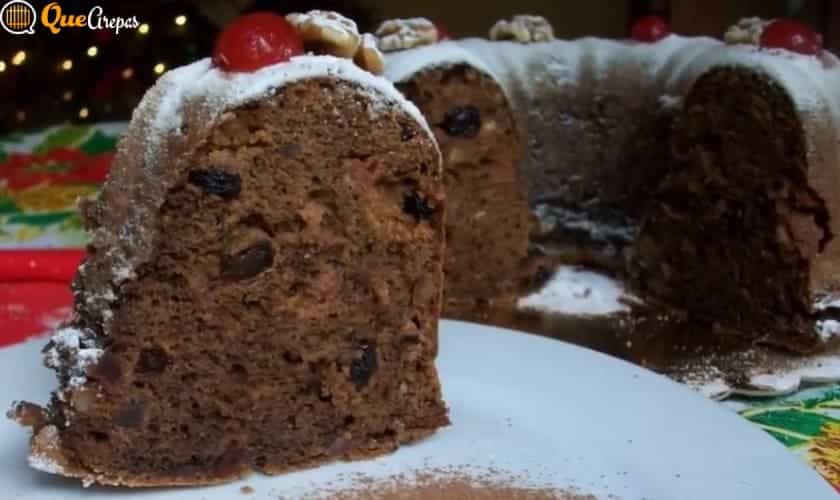
Bienmesabe Venezolano, Quesillo Venezolano, Torta de Pan, Conservas de Coco, Dulce de Lechoza, Majarete de Coco Venezolano
Venezuelan Black Cake is an exquisite dessert that fuses the richness of local ingredients with a touch of historical essence. Known for its distinctive flavor and dark, enticing appearance, this torta is a true symbol of festivities and celebrations in Venezuela. In this article, we will explore each element that makes this delicacy so unique and appreciated in Venezuelan culinary culture.
- What is the Venezuelan Black Cake?
- History and Cultural Significance of the Venezuelan Black Cake
- El Macerado: Infusion of Flavors and Tradition
- Sponge Cake: The Basis of Deliciousness
- The Magic of Dough: Integrating Dry and Wet Ingredients
- The Art of Mixing: Process and Technique
- The Final Touch: Baking and Presentation
- Venezuelan Black Cake Recipe - quearepas
- Tradition in Every Bite: Tasting the Venezuelan Black Cake
- Sharing the Taste: The Venezuelan Black Cake in Today's Society
- Frequent questions
What is the Venezuelan Black Cake?
Venezuelan Black Cake is a traditional and emblematic dessert of Venezuelan cuisine. Also known as "Torta de Navidad", it is especially popular during the Christmas holidays and on special occasions such as weddings and family celebrations. This cake is characterized by its dark color and rich combination of flavors and textures, the mixture of dried fruits, rum, spices and nuts in its sponge cake, symbolizing tradition and celebration in the Venezuelan culinary culture.
History and Cultural Significance of the Venezuelan Black Cake
Venezuelan Black Cake is much more than a dessert; it is a bearer of stories and traditions that have endured through generations. This sweet culinary treasure brings with it the richness of Venezuelan roots and has become an essential part of the country's cultural identity.
The heritage of the cake: A culinary legacy of generations.
Each serving of Torta Negra is woven with the threads of history, passed down from grandmothers to mothers and from mothers to sons. This culinary heritage is a tangible reflection of the passion and dedication that Venezuelan families have invested in preserving their gastronomic culture. Over the years, the recipe has been passed down carefully and with a sense of pride, keeping alive the authenticity and unique flavor of the torta.
Holidays and special occasions: The central role of cake at Christmas and weddings.
The Venezuelan Black Cake is a fundamental element in the most significant celebrations of Venezuelan culture. During the Christmas season, its presence on family tables is unavoidable. It is a symbol of unity and joy at a time when the community gathers to celebrate. In addition, this cake occupies a prominent place at weddings, symbolizing sweetness and prosperity in the new life that begins. Its inclusion in these special occasions transcends the gastronomic, becoming a tangible expression of love, friendship and shared values.
El Macerado: Infusion of Flavors and Tradition
At the heart of Venezuelan Black Cake lies a fundamental process that enhances its unique flavor and aroma: maceration. This ancestral technique consists of marinating dried fruits in rum, giving life to a kaleidoscope of flavors that evoke the tradition and warmth of Venezuela.
Raisins, dried apricots and dates: the natural treasures of maceration.
Raisins, apricot kernels and seedless dates are the main players in this dance of flavors. Each brings its own distinctive flavor profile and texture that adds depth to the cake. The raisins add sweet and juicy notes, the dried apricots bring a subtly tart touch and the dates contribute their honeyed richness. Together, they create a symphony of flavors that awaken the senses and give the cake character.
The alcoholic touch: How rum elevates flavor and texture.
Rum, an iconic distillate of the region, becomes the conductor that unites all these elements into a harmonious whole. By marinating the dried fruits in rum, an infusion is achieved that not only imparts a captivating aroma but also softens the fruits and gives them a juicy texture. In addition, the rum adds a depth of flavor, with its smoky and fruity undertones, that elevates the cake to new heights of deliciousness. It is not just an ingredient; it is the soul of the maceration, conveying the very essence of the culture and the excitement of sharing the richness of the flavors.
Sponge Cake: The Basis of Deliciousness
The heart of Venezuelan Black Cake lies in its sponge cake, a masterful creation that combines key ingredients to achieve a fluffy texture and exceptional flavor. Each element is a piece of a culinary puzzle that comes together to create a unique experience for the palate.
Eggs and butter: the foundation of fluffiness and richness.
Eggs and butter form the base of the cake, providing structure and softness. The eggs add moisture and act as binding agents, creating the cake's characteristic fluffiness. The butter, with its richness and distinctive flavor, infuses an indulgent quality that satisfies the senses.
Contrasting sugars: The combination of brown and white to balance sweetness.
The combination of brown sugar and white sugar is a delicate balance that imparts a deep, well-nuanced sweetness. The brown sugar contributes caramelized nuances and a bittersweet flavor, while the white sugar adds sweetness and lightness. This sweet alliance creates a complete and balanced taste experience.
Magic spices: Cocoa, cloves and cinnamon, the aromatic trinity.
Spices are the aromatic soul of the cake. Unsweetened cocoa powder adds a touch of deep chocolate, while cloves and cinnamon powder infuse a luscious, spicy warmth. Together, these elements form an aromatic trinity that awakens the senses and creates an inviting ambiance.
Vanilla touch: Raising the flavor profile of the cake.
Vanilla essence is a magical ingredient that enhances all the flavors present in the cake. Its subtle sweetness and exquisite aroma enhance the notes of cocoa, spices and dried fruits present in each bite. Vanilla acts as a conductor that unites all the components in a gustatory symphony that leaves a lasting impression.
The Magic of Dough: Integrating Dry and Wet Ingredients
The preparation of Venezuelan Black Cake is a careful dance between dry and wet ingredients, a choreography that culminates in an exceptional taste and texture experience. Each step is essential to achieve the perfect balance in the dough and guarantee satisfaction in every bite.
Leavening wheat flour: The key element for the spongy texture.
Leavening wheat flour is the foundation of the light and fluffy texture that characterizes the cake. It contains leavening agents that, when interacting with the wet ingredients and yeast, cause the increase in volume and the creation of air bubbles that contribute to the fluffiness. This special flour is the key to ensuring that each serving is a tender, airy bite.
Yeast for sponge cakes: Achieving the perfect height and fluffiness.
Cake yeast, also known as baking powder, is the secret behind the perfect height in each slice. As the cake bakes, the yeast reacts with liquids and generates carbon dioxide bubbles, which causes the dough to expand and create its airy structure. This yeast ensures that the cake reaches its full sponge potential.
Incorporation of dried fruits: Almonds and walnuts for a crunchy and delicious snack.
The introduction of nuts in the dough adds an extra dimension of flavor and texture. Rolled almonds and ground walnuts add a crunchy character that contrasts with the softness of the cake. Each bite reveals little surprises in the form of walnut and almond pieces, enriching the experience with their toasted flavor and earthy nuances.
The Art of Mixing: Process and Technique
Making Venezuelan Black Cake is not just about combining ingredients, but about a delicate and skillful process that culminates in the creation of a homogeneous and flavorful dough. The mixing technique plays a crucial role in the final quality of the torta, and each step is an opportunity to infuse love and passion into each slice.
Mixing sequence: Steps to achieve a homogeneous and uniform dough.
The sequence in which the ingredients are mixed is a critical factor in achieving a well-integrated dough. Start by beating the eggs with the sugar varieties until a smooth, creamy mixture is obtained. Then incorporate the melted butter and vanilla essence to create a rich, fragrant base. Adding the dry ingredients gradually, such as the leavened wheat flour and spices, prevents lumps from forming and ensures a uniform mixture. Finally, the dried fruit macerate and rum are added, allowing the flavors to amalgamate in every corner of the dough.
Care and patience: Why mixing with care is essential for the final result.
The preparation of the dough for Venezuelan Black Cake requires a touch of love and constant attention. Mixing patiently and in gentle movements ensures that the ingredients are integrated without losing their essence and texture. The dough becomes a blank canvas where flavors intertwine, and each movement has an impact on the final result. Taking care of every step of the mixing is a way to honor the recipe and tradition, ensuring that the cake rises to its maximum flavor and texture potential.
The Final Touch: Baking and Presentation
The final stage in the creation of Venezuelan Black Cake is as crucial as it is exciting. Baking is not only the step that brings the cake to life, but also offers the opportunity to add an attractive visual touch that further enhances its irresistible flavor.
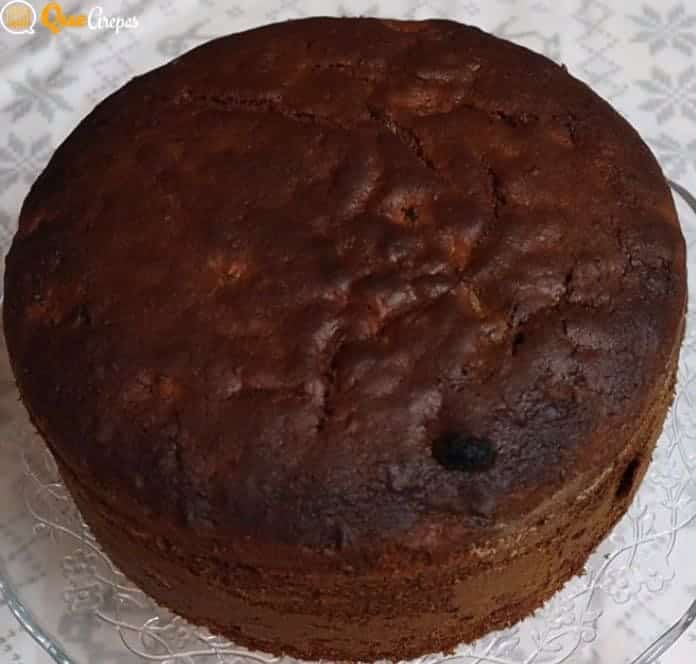
Preparing the mold: The secret to trouble-free unmolding.
The choice and preparation of the pan are essential to ensure that the cake unmolds smoothly and holds its desired shape. Line the pan with parchment paper or butter and flour to prevent the cake from sticking. Make sure the edges are well greased to facilitate unmolding. A simple but crucial step that ensures that the cake presents itself with a perfect appearance.
Time and temperature: To achieve an even, golden brown baking.
Temperature and baking time are critical factors in achieving an even, golden brown result. Following the recipe directions, bake the cake at the proper temperature and check for doneness with a toothpick before removing from the oven. The balance between temperature and time is key to bake the cake to perfection, ensuring that it is cooked through and has an appetizing golden color.
Decadent beauty: How to decorate with walnuts and almonds to enhance aesthetics.
The visual presentation is the finishing touch that elevates the Venezuelan Black Cake from a delicious treat to a culinary work of art. Decorate the top of the cake with a harmonious distribution of sliced walnuts and almonds, which add texture and a decadent look. These toasted nuts add a crunchy touch that contrasts with the softness of the cake, while their appearance generates anticipation and visual delight.
Here is the complete Recipe step by step in a video thanks to Panela Candela
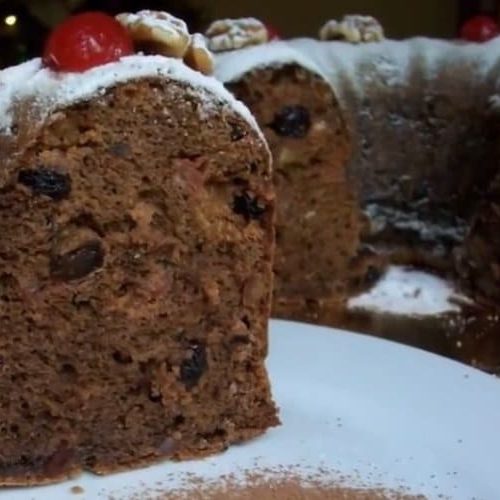
Venezuelan Black Cake Recipe - quearepas
Ingredients
For the macerate
- 60 gr Seedless raisins
- 60 gr Apricot Orejones
- 60 gr Seedless dates
- 250 ml Ron
For the cake
- 6 Unit Eggs
- 300 gr Butter
- 125 gr Brown Sugar
- 125 gr White Sugar
- 1 tbsp Unsweetened cocoa powder
- 1/2 tbsp Powdered cloves
- 1/2 tbsp Cinnamon powder
- 1/2 tbsp Vanilla essence
- 325 gr Leavening wheat flour
- 2 tbsp Baking powder (baking powder)
- 60 gr Rolled almonds
- 60 gr Ground walnuts
Instructions
Preparation of the macerate
- Prepare the ingredients: Carefully weigh the seedless raisins, apricot dried apricots and seedless dates. Make sure they are in small, manageable pieces.
- Combine the ingredients: In a large bowl, place the raisins, apricot kernels and dates. Pour the rum over the ingredients until completely covered. Be sure to use a good quality rum for richer flavors.
- Mix and cover: With a spoon or spatula, gently mix the ingredients so that they soak evenly in the rum. Then cover the container with plastic wrap or an airtight lid and let it sit for at least 24 hours. During this time, the flavors will meld and the macerate will reach its full potential.
Preparation of the cake
- Beat the eggs: In a large bowl, beat the eggs until light yellow and frothy. You can use an electric mixer or do it by hand with a wire whisk.
- Add the butter and sugars: Add the room temperature butter, brown sugar, and white sugar to the bowl with the beaten eggs. Continue beating until you get a smooth and homogeneous mixture.
- Add the dry ingredients: Add the unsweetened cocoa powder, clove powder, cinnamon powder, and vanilla essence to the mixture. Mix well to make sure all the ingredients are evenly distributed.
- Sieve the flour and yeast: Sift the self-rising wheat flour and the two tablespoons of biscuit yeast (baking powder) over the mixture. This will help prevent lumps and ensure a light texture to the cake.
- Add the almonds and walnuts: Add the sliced almonds and ground walnuts to the cake batter. Mix gently so that they are evenly distributed in the dough.
Union of the macerate and the biscuit
- Prepare the pan: Grease and flour a suitable size cake pan. Be sure to cover all surfaces to prevent the cake from sticking to the pan during baking.
- Combine the mash and cake: Gently pour the mash over the cake batter and use a spatula or spoon to carefully mix until fully integrated. Make sure all the ingredients are evenly distributed.
- Pour the batter into the pan: Transfer the cake mix and mash to the prepared pan. Smooth the surface with a spatula to even it out and ensure the cake cooks evenly.
- Once you have combined the mash and the squint, the cake is ready to be baked following the specific temperature and time directions in the recipe.
Video
Notes
Nutritional information
The nutritional information for the Venezuelan Black Cake may vary slightly depending on the specific recipe and the servings served. Below is a general approach based on the mentioned ingredients: Serving Size: 1 slice (about 100 grams) Calories: 380 kcalTotal fat: 18 g
- Saturated fat: 8g
- trans fat: 0g
Cholesterol: 70mg
Sodium: 180mg
Total Carbs: 50g - Dietary fiber: 2 g
- Sugars: 32g
Proteins: 4g
Tradition in Every Bite: Tasting the Venezuelan Black Cake
The culmination of all the effort and passion invested in the creation of the Venezuelan Black Cake is fully experienced at the moment of tasting. Each bite reveals a symphony of flavors and textures that resonate with the rich Venezuelan culinary tradition.
Texture and flavor: The balanced combination of softness and crunch.
The first bite transports you to a world of contrasts: the spongy softness of the cake intertwines with the crunchy texture of walnuts and almonds on top. It's this balance between tender and crunchy that makes each bite a complete sensory experience. Texture plays an important role as each component comes together in harmony to deliver a satisfying mouthfeel.
Fruity and spicy notes: Discovering the nuances in each bite.
As you explore deeper, a wealth of flavors is revealed that tells the story of the Venezuelan Black Cake. The fruity notes of raisins, dried apricots and dates mix with the aromatic spices of cocoa, cloves and cinnamon. Each bite is like a brushstroke of flavors that unfold on your palate, revealing nuances and layers that capture the essence of Venezuelan culture.
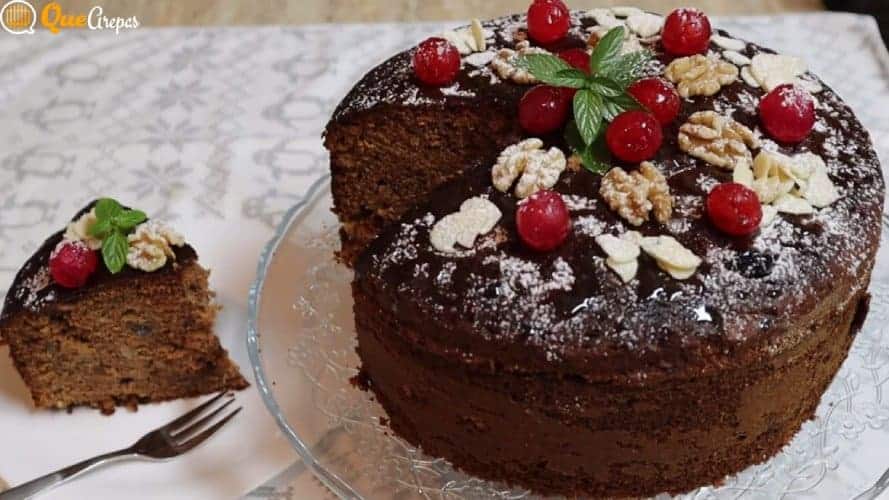
Sharing the Taste: The Venezuelan Black Cake in Today's Society
The Venezuelan Black Cake is not only a culinary treasure, but also a bond that unites generations and transcends time. In today's society, its place is just as relevant, whether it is keeping tradition alive or exploring new ways to delight the palate.
Keeping the tradition alive: The importance of transmitting the recipe to the new generations.
In an ever-changing world, keeping the tradition of the Venezuelan Black Cake alive is an act of cultural preservation. Passing on the recipe to new generations not only ensures that the authenticity of this culinary treasure endures, but also creates bridges between the past and the present. By involving young people in the preparation of the cake, it fosters a sense of connection to the roots and celebrates the culinary heritage that has endured through generations.
Creative variants: How to reinvent the cake while respecting its essence.
As cooking evolves, there is also room for creativity in the interpretation of classic recipes. While the Venezuelan Black Cake is loved for its tradition, there is room for innovation. Adding new ingredients or adapting the recipe to current dietary preferences can provide freshness without losing the essence. However, it is crucial to maintain a balance, respecting the fundamental flavors and values that make the cake unique.
You can continue enjoying more Venezuelan desserts after savoring some delicious arepas.
Frequent questions
How long should the mash be mashed?
It is recommended to macerate the raisins, apricot dried apricots, dates and rum macerate for at least 24 hours so that the flavors mix and intensify.
Can I substitute the rum in the macerate?
If you don't want to use rum, you can substitute dark fruit juice, such as unsweetened grape juice concentrate, for a non-alcoholic alternative.
Is it necessary to use self-rising wheat flour?
Self-rising wheat flour is preferable in the Venezuelan Black Cake recipe, as it helps the cake rise properly. If you don't have self-rising wheat flour, you can use regular wheat flour and add additional baking powder.
What's the best way to bring the mash and biscuit together?
After preparing the cake, allow it to cool completely. Then, place the cake on a serving plate and pour the mash over it. Let the cake absorb the mash for at least a few hours or preferably overnight for a better fusion of flavors.
How long does it take to bake the Venezuelan Black Cake?
Baking time may vary depending on the oven and the size of the pan used. In general, it is recommended to bake the Venezuelan Black Cake at a temperature of 180-190°C for approximately 1 hour. However, it is important to test with a toothpick to ensure that it is fully cooked in the center.
If you want to know other articles similar to Venezuelan Black Cake: A Delicious Feast of Flavors and Tradition you can visit the category Desserts.

